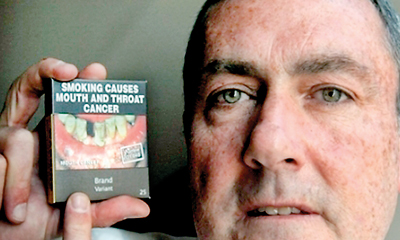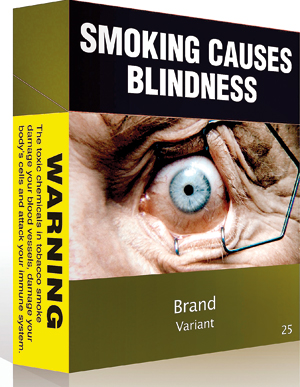Sunday Times 2
Australia’s ‘Disgusting’ Cigarette Packs
View(s):A law forcing tobacco firms to sell cigarettes in plain packets came into effect in Australia yesterday in an effort to strip any glamour from smoking and prevent young people from taking up the habit. The new law, the first of its kind anywhere the world, came into force despite a vigorous legal challenge by big tobacco, which argued that the legislation infringed its intellectual property rights by banning trademarks.

British American Tobacco Australia CEO David Crow displays one of the drab olive-green cigarette packets (AFP)
All cigarettes will now have to be sold in identical, olive-brown packets bearing the same typeface and largely covered with graphic health warnings.
A cashier at a Sydney newsagent said many customers reported finding the new packaging, which must feature graphic images such as a gangrenous foot, mouth cancer or a skeletal man dying of cancer, off-putting.
Sanjid Amatya said smokers were asking to pick and choose the images on their packets, with the photograph of gangrenous toes bothering many consumers, as well as one of a sick child affected by cigarette smoke.
“Some of them don’t care what the picture is,” Amatya said from the store in the suburb of Wynyard where he has worked for three years.
“But some say ‘Why did they change the pictures? It’s so awful’.”Anti-smoking campaigners have welcomed the new law, which stipulates that 75 percent of the front of packets must feature the graphic images.
Stafford Sanders from Action on Smoking and Health (ASH) Australia told AFP that research had suggested people would be put off by the packaging.
“It will de-glamourise the packet.” Sanders said some people had become quite upset and offended by the images.
“The images are supposed to be disturbing, to be confronting. They are supposed to have an effect,” he said. “If the images stop one child from taking up smoking, hasn’t it been worth you being offended by it?”The number of smokers in Australia has dropped from about 50 percent in the 1950s to 15 percent now and the government is aiming to push it down to 10 percent by 2018. With 80 percent of smokers starting before the age of 18, and 99 percent before they turn 26, health authorities hope the new packaging will have the biggest impact on young people.

This handout image taken and released by the Australia government shows the new compulsory cigarette packet style in dark olive-green and plastered with health warnings (AFP)
“If we can prevent young people from taking it up, that’s a lifetime gift to them,” Health Minister Tanya Plibersek said on Friday ahead of the law coming into effect.
Smoking is one of the leading causes of preventable death and disease in Australians, killing an estimated 15,000 every year.
The government says it will not be heavy-handed in enforcing the legislation in cases where a few packets of old cigarettes are sold in error, but there is the possibility of fines of more than Aus$1 million for a corporation that commits a large and deliberate breach of the law.
‘Uncool’ teenagers take up smoking to fit in with their peers
By Claire Bates
Films and old TV shows may have portrayed smokers as part of the high school elite, but research has shown it is the ‘nerds’ who are most likely to pick up the habit.
A study from Sweden has revealed that having a low peer status as a teenager is a strong risk factor for regular and heavy smoking in adulthood.
The lower a person’s street cred was at school the more likely they were to continue the unhealthy habit later on.
Researchers from Stockholm University in Sweden used a large database that followed 15,000 people mainly from the Stockholm area, from birth to middle age.
The researchers isolated 2,329 people who were interviewed once at age 13 about peer status at school and again at age 32 about their smoking habits. The results found a direct correlation between low popularity and smoking.
The study benefited from an objective measure of peer status, as students were not asked to assess their own status but instead nominated the three classmates they ‘best liked to work with at school’.
By checking the responses of all classmates from each school, the researchers identified students from the marginalised to the favourites.
Students with few nominations were assumed to be less accepted and respected within the group and to have fewer friends.
There are several possible reasons why low status children grow up to become smokers. Unpopular teenagers may come to believe in their low status, which may influence unhealthy life choices.
Marginalised people may be more likely to adopt controversial behaviours, such as smoking, while ‘favourites’ conform to social expectations of good behaviour. Unaccepted youngsters may also take up smoking in school as a bid for attention or popularity, with the smoking habit – via nicotine addiction – continuing into adulthood.
The researchers said the study suggested anti-smoking programmes in schools would be more effective if they also increased integration and fostered acceptance.
© Daily Mail, London
Follow @timesonlinelk
comments powered by Disqus
























